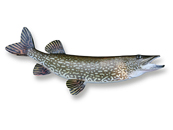Northern Pike
Esox lucius
AKA: Water wolf, common pike, snake, great northern pike, American pike, jackfish, Great Lakes pike, grass pike, and pickerel.
The northern pike got its name because of its North American habitat and the fact that it resembles the pole-weapon known as a pike.
-
Distinguishing Markings:
The northern pike is an elongated fish. Its dorsal region is bluish-green to gray in color, shading to white or yellow on the belly. This coloration distinguishes it from chain pickerel, redfin pickerel, muskellunge, and other members of the pike family. The northern pike’s scales have irregular rows of yellow or gold bean-shaped spots. They also have fully scaled cheeks and large sensory pores on each side of the ventral surface of the lower jaw. This characteristic makes northern pike a close relative to muskellunge, but with light markings on their dark body backgrounds and less than 6 sensory pores on the underside of their jaw. The mouth is duck-bill shaped and lined with many sharp canine teeth.
-
Size:
Northern pike can grow more than three feet long and weigh as much as 50 pounds, although larger sizes have been reported, particularly in the Great Lakes area.
-
Distribution:
The voracious and carnivorous northern pike has a range greater than any other freshwater gamefish, and can be found throughout the northern half of North America including northern New England, eastern New York, Minnesota and the Ohio Valley, the Great Lakes basin and also the surrounding states of Nebraska and Missouri. Toward the north, pikes are also found in Alaska and Canada, except, British Columbia.
-
Habitat:
Northern pike prefer clear, shallow, vegetated areas of lakes and larger rivers with plenty of stumps, aquatic vegetation, or other cover.
-
Food:
Northern pike primarily eat fish, preying on golden shiners, yellow perch, bluegills, and suckers. Young pike feed on zooplankton and aquatic invertebrates, before switching to a fish diet. Large pike have been known to eat on ducklings, small waterfowl, and small muskrats.
-
Spawning:
Spawning takes place soon after ice-out when temperatures reach 35 F in shallow waters. The female broadcasts the eggs over aquatic vegetation while two or more males fertilize them. A large female northern pike can produce 250,000 to 500,000 adhesive eggs that stick to the vegetation and hatch within six to 29 days, depending on water temperature. Young pike typically reach six inches by their first fall and attain sexual maturity in three years. Pike can live to 24 years.
Northern pike can breed with muskellunge to produce a subspecies known as tiger muskellunge (Esox masquinongy immaculatus). There is also a silvery-blue or silver mutation known as the silver pike or silver muskellunge, occurring in scattered populations.
-
Fishing Tips:
A highly prized gamefish, the northern pike is fantastic to catch because of its sheer size, strength, and fighting ability. Usually found in cold, clear, rocky waters, lakes and streams, northern pike are ambush hunters, laying hidden, waiting for prey, which are caught sideways with their sharp teeth. Northern pike are some of the biggest freshwater fish; anglers enjoy the challenge involved in facing the aerial acrobatics and explosive hits. Use large spoons or minnow-type lures fished along the edges of weedbeds to catch northerns. Another popular method is to fish a large live golden shiner or sucker beneath a large bobber early in the season in shallow coves.
The meat is white, flavorful, and has a flaky texture, but is quite boney. Northern pike is usually filleted and particularly popular in many German dishes. References from the ancient Romans depict pikes served at festivities.


